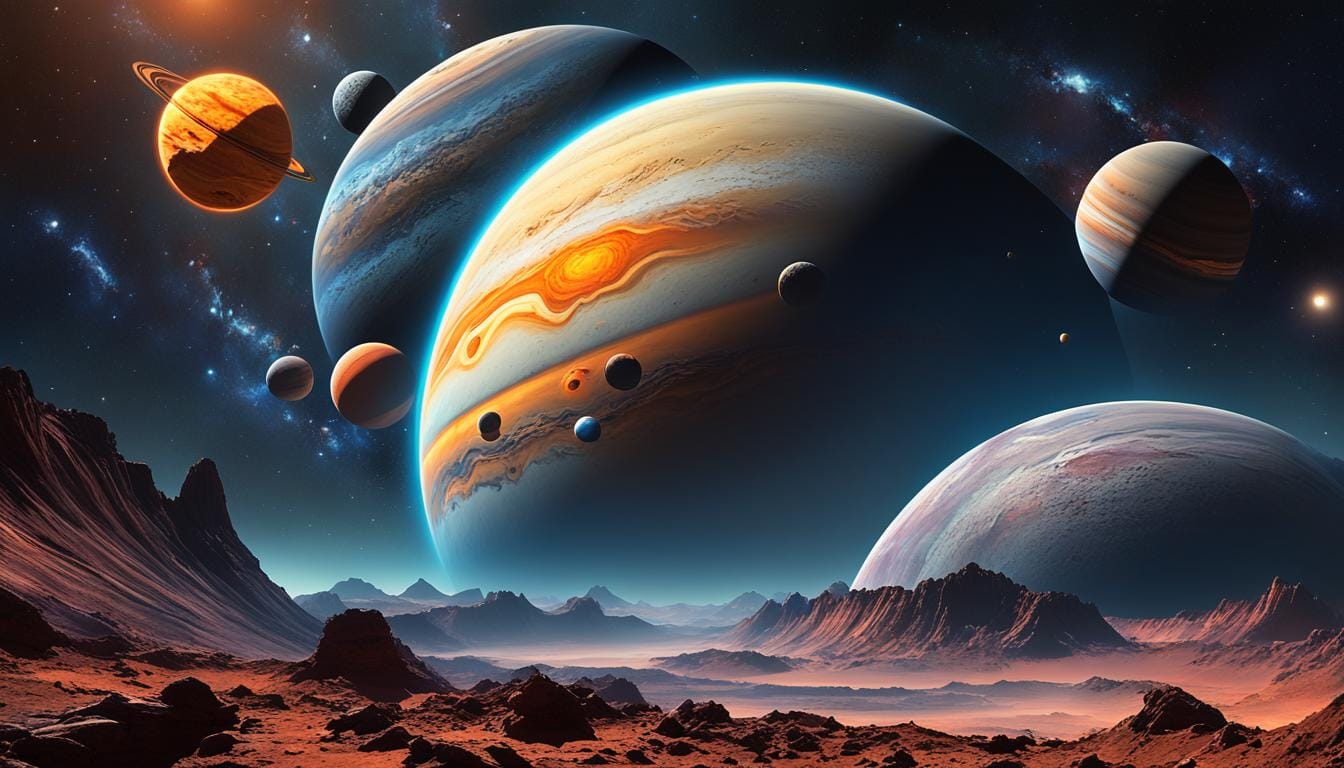Black holes are mysterious and awe-inspiring objects in space. They form when massive stars collapse under gravity. Their gravity is so strong, not even light can escape.
One fascinating thing about black holes is the “event horizon.” It’s the point where nothing, including light, can escape. Once something crosses it, it falls towards the center, where physics as we know it ends.
Black holes also bend light from far-off galaxies, a phenomenon called gravitational lensing. This lets scientists see the early universe and how it formed.
At the heart of most galaxies are supermassive black holes. These giants are millions or even billions of times heavier than our Sun. They power the brightest objects in space, like quasars.
Smaller black holes, made from massive stars, have their own quirks. For example, they can stretch and tear apart objects that get too close.
Studying black holes helps us understand space, time, and the universe’s evolution. They are still full of mysteries waiting to be solved.
What is a Black Hole?
A black hole is a cosmic wonder – an incredibly dense object in space where not even light can escape. It forms when a massive star, much bigger than our Sun, dies and collapses in on itself. This creates a gravitational singularity by warping space and time.
Black holes come in all sizes, from tiny ones as small as an atom to huge ones called supermassive black holes. These supermassive ones can be as heavy as 1 million times our Sun. The one at the center of our galaxy, Sagittarius A*, is about 4.3 million times heavier than the Sun.
Even though black holes are super dense, they wouldn’t pull the Earth out of orbit if they replaced the Sun. This is because they have the same gravity as the Sun but in a much smaller space. But, stars like our Sun can’t become black holes. Only the collapse of a massive star can make a black hole.

Scientists use telescopes and satellites to study black holes. They want to learn more about these amazing objects and their role in the universe. From tiny stellar black holes to huge ones at galaxy centers, black holes are fascinating and mysterious.
Black Holes Don’t Suck
Many think black holes pull in everything around them. But, they’re just like other space objects, with a strong gravitational field. If the Sun turned into a black hole of the same mass, Earth would still orbit it. This is because the gravity of the black hole would be the same as the Sun’s.
Black holes seem to pull in matter because of how they interact with nearby stars. Stars can lose material that falls into the black hole. This makes people think black holes suck in everything. But it’s really the strong gravitational field that distorts and speeds up nearby matter.
Black holes have a very strong gravity, but they don’t act like a cosmic vacuum. They follow the same laws as any massive object in space, but on a much stronger scale.
Escape Velocity and Time Dilation
The speed needed to escape a planet is called its “escape velocity.” For black holes, this speed is faster than light. So, nothing, not even light, can escape once it crosses the event horizon.
The gravitational field of a black hole also slows down time near it. This effect, called time dilation, is from Einstein’s theory of general relativity. It has been seen in real-world experiments and observations.
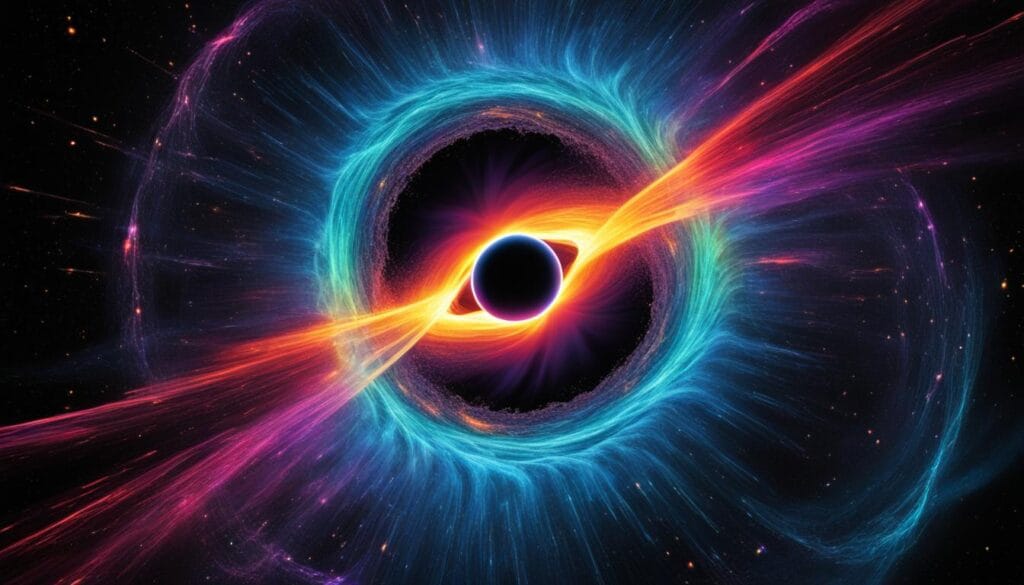
Black holes aren’t the monsters of science fiction. They form when huge stars collapse. Their gravitational field and behavior follow the laws of physics.
Event Horizon and Singularity
At the center of a black hole is a mysterious event: the event horizon. This invisible line marks the point where nothing, not even light, can escape. Once something crosses this line, it’s pulled towards the singularity, where physics as we know it ends.
The idea of the event horizon started in the 1950s with physicist Wolfgang Rindler. Before him, in 1784, John Michell thought of objects so dense they could trap light. But it was David Finkelstein in 1958 who defined the event horizon as the point of no return.
As objects get close to the event horizon, they seem to slow down. Stephen Hawking talked about an “apparent horizon” instead. He believed that gravity causes these horizons but not all of them are true event horizons.
The event horizon isn’t just for black holes; it’s also important for the universe’s growth. In an expanding universe, signals can’t reach certain areas. This cosmic event horizon affects all signals, including gravitational waves.
At a black hole’s core is the singularity, where physics fails us. The Schwarzschild solution shows how gravity works outside a massive object. If the object is heavy enough, it becomes a black hole with an event horizon and a singularity.
The Kerr solution is for rotating black holes. Here, the singularity is a ring, not a point. It can be spacelike or timelike, based on the black hole’s spin. This idea challenges our understanding of the universe and our theories.
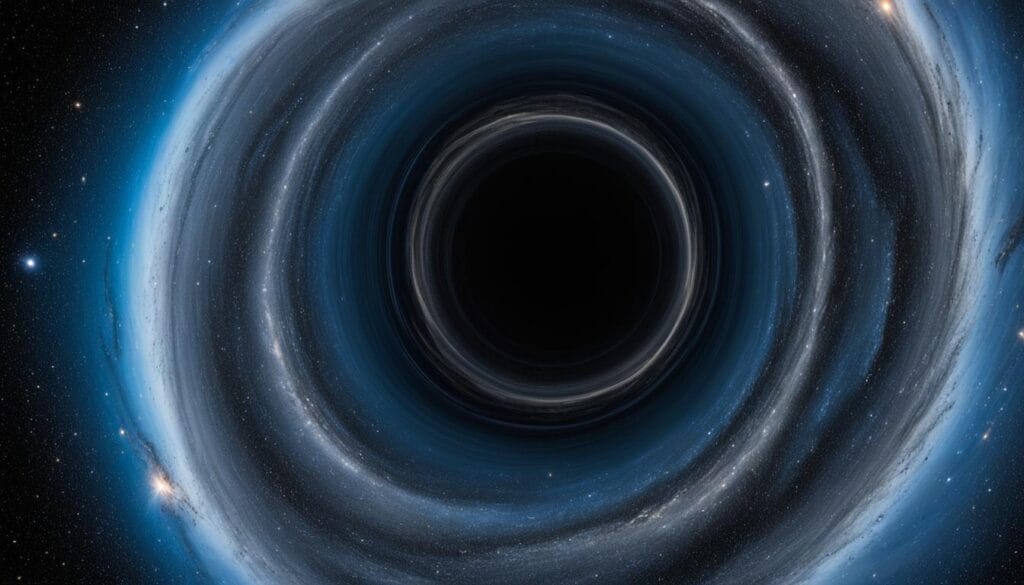
Gravitational Lensing
Black holes can bend and change the path of light from far-off galaxies. This effect is called gravitational lensing. It lets scientists see into the early universe. By studying how black holes change light, they learn about these distant objects.
Recently, scientists found a huge black hole, over 30 billion times bigger than our Sun. This ultramassive black hole shows the huge effect of gravity. Its gravity lensing matched the path of light from a distant galaxy, seen by the Hubble Space Telescope.
Gravitational lensing does more than just magnify distant objects. It helps scientists study inactive black holes. These black holes don’t take in matter or give off energy. This gives us a better look at these mysterious objects.
A team from Durham University in the UK led this discovery. They got support from the UK Space Agency, the Royal Society, and the STFC. Their work, in the Monthly Notices of the Royal Astronomical Society, shows how gravitational lensing helps us understand the early universe and distant galaxies.
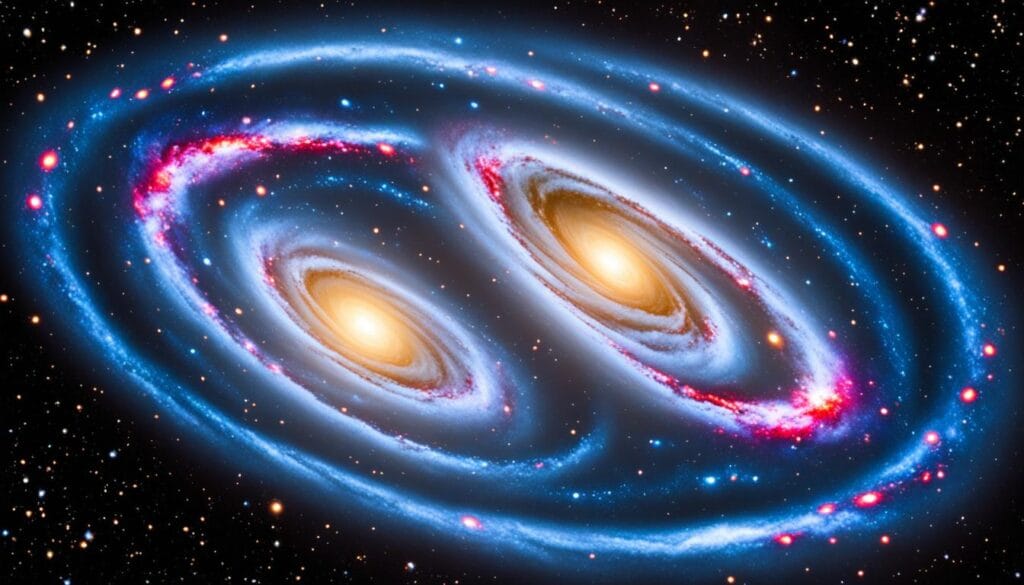
Black Hole Phenomena
Black holes are not just dense objects in space – they show us amazing phenomena. They have things like spaghettification and Hawking radiation. These things make scientists and the public very interested.
Spaghettification
Spaghettification is a weird process of black holes. If something, like a star or an astronaut, gets too close, it gets pulled apart. It looks like spaghetti because the gravity pulls it in different ways.
This shows how strong the gravity is near a black hole. It’s a clear sign of the huge forces at work.
Hawking Radiation
Hawking radiation is another interesting thing about black holes. It was named after Stephen Hawking. He showed that black holes can lose mass over time, not just gain it.
This idea changed how we see black holes and physics. It made us rethink our understanding of the universe.

These are just a few examples of the amazing things black holes do. As we learn more about them, we’ll discover even more surprising things about the universe.
Accretion Disks and Jets
Black holes are amazing objects that capture the interest of scientists and the public. They interact with matter and energy in a fascinating way. When matter falls into a black hole, it forms a spinning accretion disk around it. This disk heats up and sends out radiation across the spectrum.
The creation of these disks happens because of the strong gravity of the black hole. The material in the disk gets incredibly hot, emitting X-rays and high-energy radiation. This radiation helps scientists learn about the black hole and what happens near it.
Powerful Jets from Black Holes
Some black holes also create powerful jets of particles and energy. These jets move at almost the speed of light and can stretch for thousands of light-years. They are thought to be powered by the black hole’s strong magnetic fields.
How these jets form is still a mystery, but scientists think it involves complex processes. The jets tell us about the black hole’s spin, magnetic field strength, and how much it’s gaining mass.
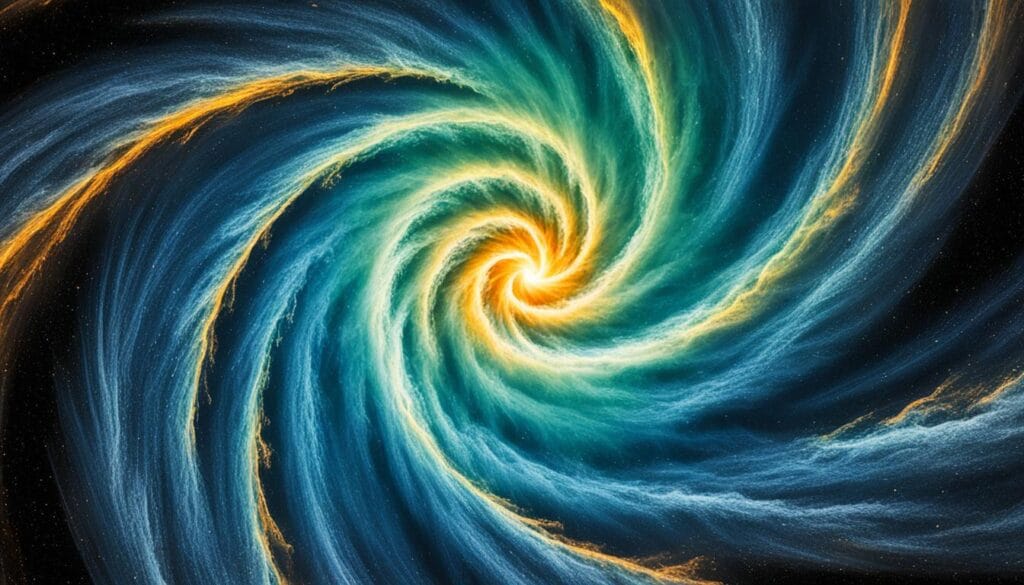
Studying accretion disks and black hole jets has greatly helped us understand extreme astrophysical processes. By looking at the radiation and particles from these areas, scientists learn about matter in extreme conditions in the universe.
Supermassive Black Holes
Most galaxies, including our own Milky Way, have supermassive black holes at their centers. These black holes are huge, with masses millions or even billions of times bigger than the Sun. The black hole at the Milky Way’s center, called Sagittarius A*, has a mass over 4 million times that of the Sun. It helps keep our galaxy together.
Supermassive black holes are those with a mass above 100,000 times that of the Sun. Some can be as massive as several billion times the Sun’s mass. The size of a nonrotating and uncharged supermassive black hole of about 1 billion M☉ is similar to the orbit of Uranus. Scientists call black holes with more than 5 billion M☉ ultramassive, but this term isn’t commonly used.
The study of supermassive black holes started with the discovery of 3C 273 in 1963 by Maarten Schmidt. This marked the beginning of studying quasars. Finding Sagittarius A* in the Milky Way’s center showed that supermassive black holes exist. In the 1960s, finding quasars gave more proof of huge black holes in space.
Studying supermassive black holes helps physicists test theories like Einstein’s general relativity. It shows how mass, space, and time are connected. Black holes also help us understand how galaxies form, stars and planets are born, and the universe evolves. Researchers keep looking into how supermassive black holes work and what they teach us about extreme physics.
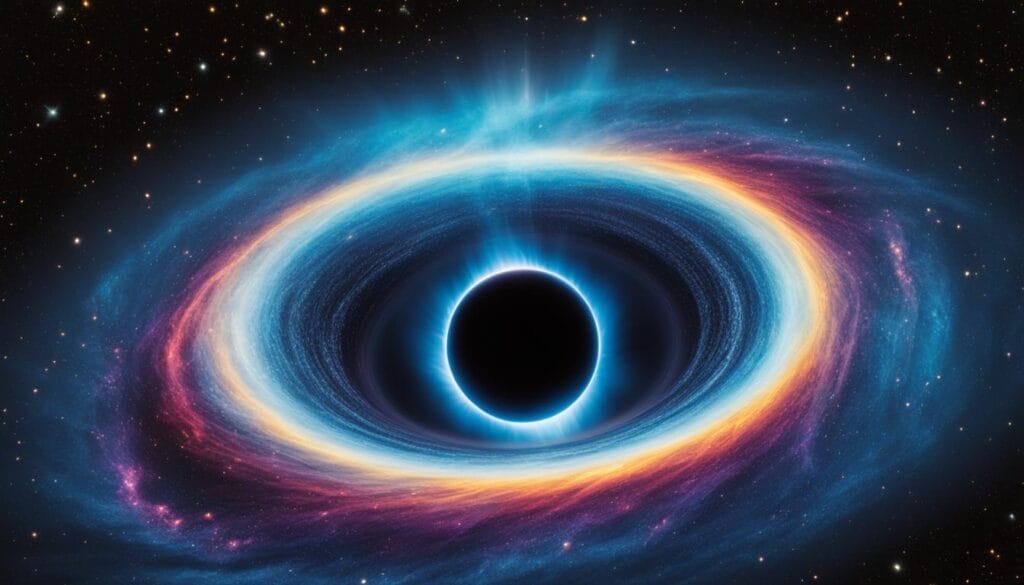
Stellar-Mass Black Holes
Stellar-mass black holes are smaller than supermassive ones found at galaxy centers. They come from massive stars collapsing or neutron star mergers. These black holes weigh from 5 to dozens of times our Sun’s mass.
The size of these black holes varies a lot. The biggest one weighs 62 times our Sun, and the smallest is just 3.3 times. There are also intermediate-mass black holes in globular clusters, linking stellar-mass and supermassive ones.
There might be a limit to how big black holes can get, at 150 solar masses. Some think there could also be a gap in size, with few black holes between 2 to 5 solar masses.
In our Milky Way, stellar-mass black holes range from 3 to over 12 solar masses. They form when massive stars, several times the Sun’s size, run out of fuel and collapse into black holes.

Studying stellar-mass black holes helps us understand how they form and change over time. As we learn more, we might find even more amazing things about the universe’s gravity.
Quasars and Active Galactic Nuclei
Quasars and active galactic nuclei shine brightly in the universe. They are powered by matter falling into supermassive black holes at galaxy centers. These events release huge amounts of energy, making them some of the brightest things in space.
Supermassive Black Holes and Galactic Centers
Most big galaxies, including our Milky Way, have supermassive black holes at their centers. These black holes can be millions to billions of times heavier than our Sun. They are key to how galaxies form and change over time.
The Hubble Space Telescope has shown that every galaxy has a black hole at its core. The size of the black hole matches the galaxy’s size. Hubble’s findings have greatly helped us understand these supermassive black holes.
Powering Quasars and Active Galactic Nuclei
Quasars and active galactic nuclei get their power from matter falling into supermassive black holes. This matter forms a bright disk around the black hole. This disk can shine much brighter than the whole galaxy.
Quasars are the brightest of these objects. Blazars are similar but change brightness quickly. They have a jet aimed right at Earth, making them seem even brighter.
Even though quasars and active galactic nuclei are very bright, they don’t harm their galaxies much. The gas cools down, and stars can start forming again. However, they might stop star formation for a while by heating the galaxy’s gas.
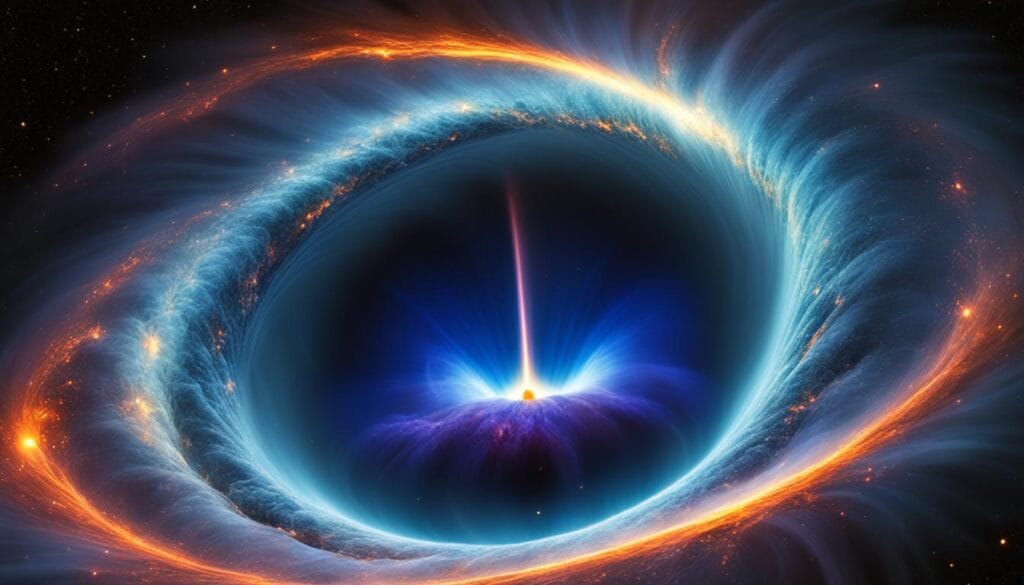
The James Webb Space Telescope will soon give us new details about quasars, active galactic nuclei, and supermassive black holes. It will show us how these objects worked in the early universe.
Gravitational Waves
The universe is full of cosmic rhythms, with objects moving in harmony. At the center, gravitational waves play a key role. These waves are like ripples in space-time, made by huge events like black holes or neutron stars merging. Scientists use tools like LIGO and Virgo to study these waves.
For over ten years, scientists have been searching for gravitational waves. The NANOGrav team, with nearly 100 researchers from many countries, is leading this search. They use about 70 pulsars to look for signs of gravitational waves.
The NANOGrav team has found a pattern in their data that could mean gravitational waves are real. This team is working with others around the world. They hope to find more proof of these waves soon.
Finding out about gravitational waves has been hard, but scientists keep trying. They think different things could make these waves, like cosmic strings or dark matter. As their tools get better, they might learn more about these waves.
In 2015, LIGO found gravitational waves from two black holes merging. This was a big deal for science. These waves can tell us a lot about the universe’s extreme events. As scientists learn more, they might uncover more secrets of the universe.
Black Hole Collisions
The collision of black holes is a fascinating event that has grabbed the interest of scientists around the world. Recent breakthroughs in detecting gravitational waves have given us new insights into these cosmic events. They show us how black holes work and how the universe changes over time.
Scientists have found a gravitational phenomenon called precession in black hole collisions. Albert Einstein predicted this a long time ago. The merged black holes sent out huge waves through space-time, called gravitational waves. These waves let us see these powerful events in a new way.
The spinning black hole in the collision was spinning at an incredible speed. It was spinning 10 billion times faster than any other black hole before. The black holes were much bigger than our sun, with the bigger one about 40 times as massive. After the collision, the new black hole was likely thrown out of its galaxy at over 3 million mph.
The precession effect from the collision was incredibly fast, 10 billion times faster than before. The bigger black hole was spinning almost at its top speed. This event could change how we think about how binary black holes form. It might mean we need to update our theories.
Detectors like Advanced LIGO, Virgo, and KAGRA have found over 80 merging black holes or neutron stars. With new upgrades and the LISA Pathfinder mission, we expect to find hundreds more black hole collisions soon. This will give us even more insights into these 13 amazing cosmic events.
Black Hole Imaging
In 2019, the Event Horizon Telescope (EHT) made history by capturing the first-ever image of a black hole. This image showed the shadow of a supermassive black hole at the center of the galaxy M87. It was the first direct visual proof of these mysterious cosmic objects.
The EHT uses telescopes around the world to work together as one giant telescope. This lets it take pictures of black holes. The Atacama Large Millimeter/submillimeter Array (ALMA) in Chile, with 66 precise antennas, was part of this effort.
The black hole seen by the EHT is called M87*. It’s in the M87 galaxy, about 53 million light-years away, and has a mass of 6.5 billion suns. Over 300 researchers from 80 institutes worldwide worked together to capture an image of a smaller black hole, showing how size relates to mass in these objects.
The EHT collected data in April 2017, which was then processed in the US and Germany. This took several months to produce the final image. The EHT can see objects 4,000 times better than the Hubble Space Telescope, thanks to its precise telescope synchronization.
Future images from the EHT will be even clearer with more telescopes and considering Earth’s rotation. This breakthrough in black hole imaging, thanks to the Event Horizon Telescope, has greatly expanded our knowledge of the M87 black hole and these mysterious cosmic phenomena.
| Telescope | Location | Contribution |
|---|---|---|
| ALMA | Atacama Desert, Chile | 66 high-precision antennas, sensitive to larger scales |
| Sagittarius A* | Milky Way Galaxy | Closest supermassive black hole, 4 million solar masses |
| M87* | Messier 87 Galaxy | Supermassive black hole, 6.5 billion solar masses |
Black Holes and the Early Universe
Some of the most distant and oldest black holes were formed just a few hundred million years after the Big Bang. They give us clues about the early universe’s formation and evolution. These ancient black holes let us peek into the conditions and processes of the cosmos’s early days.
Computer simulations have shown that large black holes can be found in unexpected places. This challenges what we thought before. Even the smallest galaxies can have massive black holes, not just at the center. Out of 25,000 dwarf galaxies studied, 151 were found to have big black holes. This suggests most galaxies might have them.
Scientists think the big black holes in dwarf galaxies might be old relics from the early universe. They could help us understand how the first black holes formed. The masses of these early black holes might explain how the biggest black holes today came to be. This gives us a look into the distant past of the cosmos.

